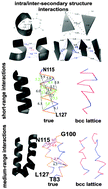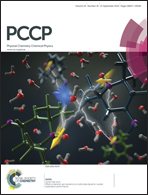Distance-dependent hydrophobic–hydrophobic contacts in protein folding simulations†
Abstract
Successful prediction of protein folding from an amino acid sequence is a challenge in computational biology. In order to reveal the geometric constraints that drive protein folding, highlight those constraints kept or missed by distinct lattices and for establishing which class of intra- and inter-secondary structure element interactions is the most relevant for the correct folding of proteins, we have calculated inter-alpha carbon distances in a set of 42 crystal structures consisting of mainly helix, sheet or mixed conformations. The inter-alpha carbon distances were also calculated in several lattice “hydrophobic-polar” models built from the same protein set. We found that helix structures are more prone to form “hydrophobic–hydrophobic” contacts than beta-sheet structures. At a distance lower than or equal to 3.8 Å (very short-range interactions), “hydrophobic–hydrophobic” contacts are almost absent in the native structures, while they are frequent in all the analyzed lattice models. At distances in-between 3.8 and 9.5 Å (short-/medium-range interactions), the best performing lattice for reproducing mainly helix structures is the body-centered-cubic lattice. If protein structures contain sheet portions, lattice performances get worse, with few exceptions observed for double-tetrahedral and body-centered-cubic lattices. Finally, we can observe that ab initio protein folding algorithms, i.e. those based on the employment of lattices and Monte Carlo simulated annealings, can be improved simply and effectively by preventing the generation of “hydrophobic–hydrophobic” contacts shorter than 3.8 Å, by monitoring the “hydrophobic–hydrophobic/polar–polar” contact ratio in short-/medium distance ranges and by using preferentially a body-centered-cubic lattice.


 Please wait while we load your content...
Please wait while we load your content...